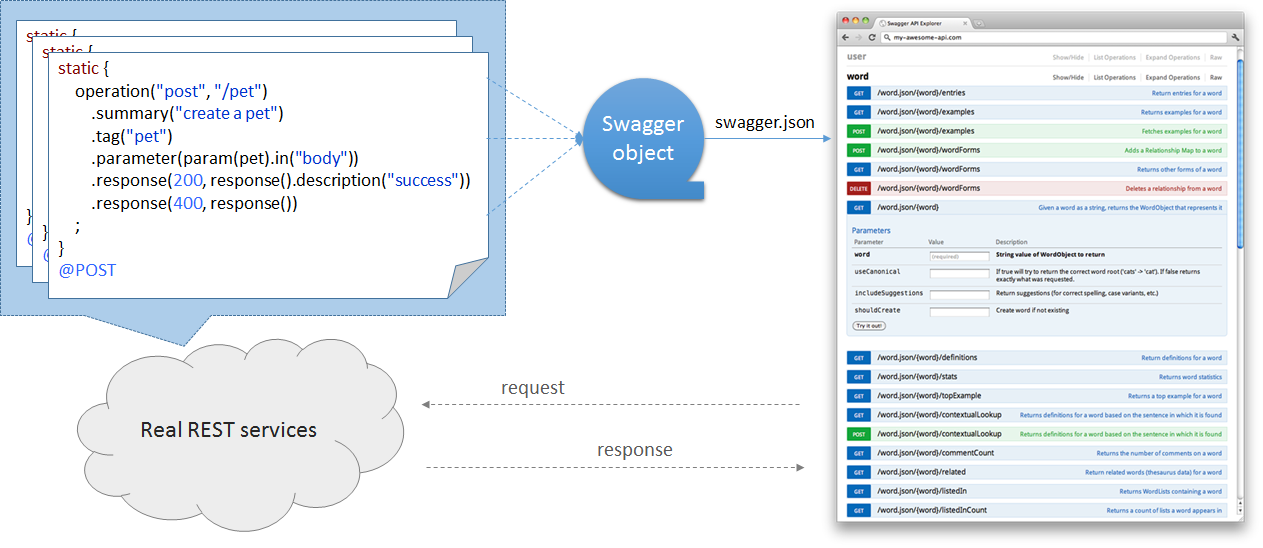I noticed, if we provided the swagger.json, swagger ui will take care of the others: dynamically build the web client, enable us online browsing the APIs, sending request to and receiving response from the real services.
binder-swagger-java was designed to help construct the swagger object (corresponding to swagger.json), and let it accessible from swagger ui or other http visitors.
You define the api meta data in classes' static code blocks, then it was collected to a static global swagger object when class scan/loading, so when requested, the program can serve it right now.
p.s.
binder-swagger-javabased onform-binder-javaandswagger-models, allow to define dynamic data structures and operate the swagger object directly when necessary, so it's more expressive in theory.
<dependency>
<groupId>com.github.tminglei</groupId>
<artifactId>binder-swagger-java</artifactId>
<version>0.6.1</version>
</dependency>// in `PetResource.java`
static Mapping<?> petStatus = $(text(oneOf(Arrays.asList("available", "pending", "sold"))))
.desc("pet status in the store").$$;
static Mapping<?> pet = $(mapping(
field("id", $(vLong()).desc("pet id").$$),
field("name", $(text(required())).desc("pet name").$$),
field("category", attach(required()).to($(mapping(
field("id", vLong(required())),
field("name", text(required()))
)).refName("category").desc("category belonged to").$$)),
field("photoUrls", $(list(text())).desc("pet's photo urls").$$),
field("tags", $(list(text())).desc("tags for the pet").$$),
field("status", petStatus)
)).refName("pet").desc("pet info").$$;
static {
operation("post", "/pet")
.summary("create a pet")
.tag("pet")
.parameter(param(pet).in("body"))
.response(200, response().description("success"))
.response(400, response())
;
}
@POST
public Response addPet(String data) throws BadRequestException, SQLException {
...// in `Bootstrap.java`
static { // for swagger
swagger().info(info()
.title("Swagger Sample App")
.description("This is a sample server Petstore server. You can find out more about Swagger " +
"at [http://swagger.io](http://swagger.io) or on [irc.freenode.net, #swagger](http://swagger.io/irc/). For this sample, " +
"you can use the api key `special-key` to test the authorization filters.")
.termsOfService("http://swagger.io/terms/")
.contact(contact().email("apiteam@swagger.io"))
.license(license().name("Apache 2.0")
.url("http://www.apache.org/licenses/LICENSE-2.0.html")
)
).host("localhost:8002")
.basePath("/api")
.consumes("application/json")
.produces("application/json")
.securityDefinition("api_key", apiKeyAuth("api_key", In.HEADER))
.securityDefinition("petstore_auth", oAuth2()
.implicit("http://petstore.swagger.io/api/oauth/dialog")
.scope("read:pets", "read your pets")
.scope("write:pets", "modify pets in your account")
).tag(tag("pet").description("Everything about your Pets")
.externalDocs(externalDocs().description("Find out more").url("http://swagger.io"))
).tag(tag("store").description("Access to Petstore orders")
).tag(tag("user").description("Operations about user")
.externalDocs(externalDocs().description("Find out more about our store").url("http://swagger.io"))
);
}// in `web.xml`
<filter>
<filter-name>SwaggerFilter</filter-name>
<filter-class>com.github.tminglei.swagger.SwaggerFilter</filter-class>
<!-- configure your extended swagger helper
<init-param>
<param-name>my-extended-swagger-helper</param-name>
<param-value>com.mycompany.pkg.MySwaggerHelper</param-value>
</init-param>
-->
<init-param>
<param-name>scan-packages-and-classes</param-name>
<param-value>com.example.resource; com.example.Bootstrap</param-value>
</init-param>
<!-- specify the path to fetch your swagger json, default '/swagger.json'
<init-param>
<param-name>swagger-path</param-name>
<param-value>/swagger.json</param-value>
</init-param>
-->
<!-- enable/disable swagger, default value: true
<init-param>
<param-name>enabled</param-name>
<param-value>false</param-value>
</init-param>
-->
</filter>
<filter-mapping>
<filter-name>SwaggerFilter</filter-name>
<url-pattern>/api/*</url-pattern><!-- keep consistent with the jersey servlet mapping -->
</filter-mapping>
...NOTES: if you extend the MSwaggerHelper and configure it here, pls ensure SwaggerFilter to be loaded eariler, that is, ensure the swagger helper to be set to SwaggerContext before other class scanner started working.
For more usage details, pls check the example project here.
Q: Why use static code blocks to associate/register operation meta info instead of annotations?
A: Well, because we can't use annotations here. Annotation requires static defined data types, but we didn't define java beans in our project.
(p.s. because of this, we can't also use existing frameworks, like springfox.)
The BSD License, Minglei Tu <tmlneu@gmail.com>
